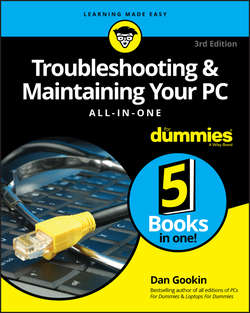Читать книгу Troubleshooting and Maintaining Your PC All-in-One For Dummies - Dan Gookin - Страница 9
На сайте Литреса книга снята с продажи.
Book 2
O, We Got Trouble!
Chapter 1
Startup Problems
Phase I: Power On
ОглавлениеDuring the initial power-on phase, the computer transforms itself from a chunk of quite useless expensive electronics into a chunk of quite useful expensive electronics.
What happens
You press the Power button. When the PC is off, pressing the Power button turns on the PC. It works that way whether the computer was properly shut down, was put into hibernation, or has met an untimely or inopportune demise.
The computer’s power supply does its job: It starts converting alternating current into direct current. Alternating current comes from the wall socket. Direct current is used inside the computer to power its circuitry and motors.
What could go wrong
The computer fails to receive power. This issue could lie with the electrical supply, a defect in the building’s wiring, or the PC’s power supply.
Troubleshooting steps
The loud sound of nothing when you turn on a PC means that it has a power supply issue. Check the following items in this order:
1. Does the PC have power?
You cannot compute when the power is off. Likewise, you cannot compute during a dip, commonly called a brownout. In that situation, the power is on but running at a low voltage. Lights work, but motors don’t. If the lights are on (dimly) but your computer doesn’t work, you may be experiencing a dip. Wait it out or check with the power company.
To ensure that a wall socket is properly supplying juice, try this test: Plug a lamp into the socket. If the lamp works, the problem lies with the computer’s power supply. If the lamp doesn’t work, buy a copy of Troubleshooting Lamps For Dummies, available at fine bookstores everywhere.
If the PC is connected to a power strip or an uninterruptible power supply (UPS), ensure that the gizmo is plugged into the wall and turned on.
2. Is the power supply on the computer operational?
When the wall socket is operating properly, the problem lies with the PC’s power supply. Such issues are easy to detect. The power supply on every PC also contains a fan: If you can hear the fan spinning, the power supply is getting power. You may need to open the case to ensure that the power supply is properly connected to the computer’s main circuitry, the motherboard.
If you don’t hear the fan and the console lights are off, the PC’s power supply may need replacing.
3. Is the monitor on?
It’s an obvious question, and even I have fallen prey to this maddening problem.
4. Is everything connected?
Both internally and externally, cables must be plugged in. Especially if you’ve just moved the computer, a cable can become unplugged easily.
Inside the PC is a different story: It doesn’t happen often, but cables can wiggle loose – especially because of wide variations in the internal case temperature or if you drop the computer or kick it down the hall.
If you complete these steps and still cannot pinpoint the origin of the nothingness, the issue is most likely too large for you to resolve on your own. Before toting the computer into the shop, however, consider its age. Old computers die. They don’t start. (Dead computers have a habit of not starting.) If your PC is more than eight years old, it might just have expired. To fix that problem, buy a new computer.
❯❯ One way to confirm a dip is to check to see whether the refrigerator or furnace fan is running.
❯❯ Some electrical circuits feature a residual-current device (RCD), also known as a ground fault interrupter (GFI) switch. This switch can trip for a variety of reasons, which cuts power to the circuit. Check for an RCD power receptacle and punch the Reset button to reactivate the circuit.
❯❯ If the RCD switch trips after you press the Reset button, call an electrician.
❯❯ Avoid the temptation to run your PC from an uninterruptible power supply (UPS) during a dip or power outage. Use the UPS power only to save your stuff and then properly shut down the computer.
❯❯ Some UPSs beep during a dip. A few models feature digital displays that may graphically show that the incoming voltage level is subnormal.
❯❯ It’s possible to use a laptop when the power is off – well, if the laptop has a charge in its battery and nothing else is awry.
“DID MY PC SECRETLY RESTART?”
If you leave your computer on all the time, you may show up one morning and discover that Windows has automatically restarted itself; rather than see the desktop, you see the logon screen.
The main reason the computer has restarted itself is that the Windows Update utility has installed a required update. That’s okay. You can direct Windows Update to prompt you, but it may still restart the computer. See Book 4, Chapter 1 for more information on Windows Update.
If the computer restarted and no updates were installed, the power company might be to blame. The computer might also have a power glitch, though if that were true, you’d see other, random restarts at various times during the day.
